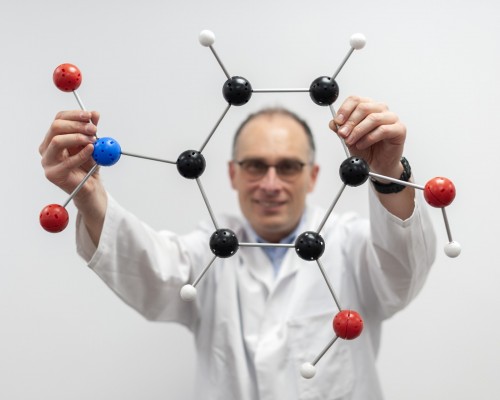Stop burning the biomass to protect your lungs
Reading time: about 9 minuts

The air over urban sites have much more complex chemical composition than we think. The complexity arises from the presence of air-suspended solid or liquid particles and other organic or inorganic pollutants that interact with each other under solar radiation. These processes make the Earth’s lower atmosphere a real “toxic cocktail” that shape our lives and well-being at places we dwell in. The recent research demonstrated by researchers from the Institute of Physical Chemistry Polish Academy of Sciences in collaboration with foreign partners explains the effect of biomass burning products, namely 4-nitrocatechol and levoglucosan on the behavior of epithelial human lung cells that are the first barrier between the bloodstream and harmful compounds that are present in the air. This work emphasizes the urgent need to extend air quality networks across the European Union by monitoring the concentrations of key biomass burning markers (i.e., 4-nitrocatechol and levoglucosan) in PM2.5 aerosol. Why? The research firmly proved their cytotoxic nature and capacity to severely demolish mitochondrial regions of human lung cells.
Our lungs are in danger. This is due to the presence of toxic organic compounds bound to the suspended solid or liquid matter, denoted as aerosol particles, which are present at elevated concentrations in the lower atmosphere over urbanized places. The important sources of aerosol particles are geological processes, volcanic activities, sea sprays but also wild fires that severely annihilates Earth’s ecosystems in drought regions around the world.
However, far more relevant for the atmospheric aerosol budget are particles formed through complex chemical processes of volatile pollutants that enter the atmosphere due to human activities or living vegetations. These volatiles play a key role in plant self-defence systems plant/animal communication and vegetations, but importantly can be released by man-made activities such as biomass burning for household heating or biowaste incineration. Once all these compounds get to the lower atmosphere, they immediately enter complex reaction networks with ozone, free radicals and other gaseous pollutants, such as nitrogen and sulfur oxides (NOx, SO2) and… here the whole story begins.
Solid particles of a nanoscale range that exist in the lower atmosphere, such as mineral dust, rock grains, plant debris and bacteria residues serve as a platform for condensation of products from aforementioned reactions. This is the onset of the organic aerosol particle growth. It is worth stressing that the resulting thin films of trapped reaction products undergo further chemical modifications that result in aged aerosol particles, which we breath in while exposed to polluted air. Surely, it is not beneficial to our health, and especially to our lung’s cells, which stand on the front line of defense.
Luckily, human cells are selective and have evolved biochemical mechanisms to defeat tiny intruders. They activate enzymes that alter the polarity of chemical intruders (xenobiotics) through oxidation processes, ultimately breaking them down to less harmful products, like carbon dioxide and water. However, the smaller the particle size is, the more easily they can diffuse into cells of other tissues, causing inflammation and oxidative stress processes that explain many adverse human health effects. A comprehensive study led by a research team from the IPC PAS (Dr. Faria Khan, Dr. Karina Kwapiszewska, Dr. Krzysztof Rudzinski and Prof. Rafał Szmigielski) in cooperation with the University of North Carolina at Chapel Hill (Prof. Jason Surratt) and Príncipe Felipe Research Center in Spain (Dr. Alicia M. Romero, Dr. Domingo Gil-Casanova) aimed at understanding whether aerosol particles originated from biomass burning are inert to human lung cells or may cause health risks. In other words, they approached the problem from a cell side: are the biomass burning products toxic to a lung cell, and if so, what are symptoms and consequences at a biochemical level?
Since the chemical composition of particulates from biomass burning are complex, each biomass burning product shows some toxicity to cellular processes, from cellular respiration to metabolic pathways, which is dependent on its concentrations (doses) and exposition time. Based on our previous studies, the composition of biomass burning aerosol is by far dominated by two end products – levoglucosan and 4-nitrocatechnol. Biomass burning is a process where polysaccharide-based polymers undergo thermal degradation (pyrolysis) leading to both polyhydroxylated derivatives and aromatic compounds. Levoglucosan, as a glucose anhydride, is a product of a glucose pyrolysis, in which a chain breaks down and released monomeric units easily dehydrate. On the other hand, 4-nitrocatechol is a phenolic compound derived from the pyrolysis of cellulose and hemicellulose in the presence of nitrogen oxides that form in situ in a high temperature. As a result, NOx released modify the structure of catechol, resulting in the formation of 4-nitrocatechol.
The goal of the researchers from the IPC PAS and foreign colleagues was to investigate how levoglucosan and 4-nitrocatechol affect BEAS-2B bronchial epithelial cells cultured from human lung epithelial cells and alveolar epithelial adenocarcinoma cell lines, such as A549, for which respiration cycles no longer follow the same path through the Warburg effect. Their findings confirmed that the exposure to 4-nitrocatechol disrupt the H+ ions concentration gradient between sides of the mitochondrial membrane, affecting the ADP-ATP biosynthesis. Researchers have shown that the presence of 4-nitrocatechol in the cytoplasm triggers oxidative stress responses, hypoxia induction, and disruption of mitochondrial membrane potential that affect mitochondria As a result, cells begin to behave completely differently in presence of 4-nitrocatechol and levoclucosan in cytoplasm, cellular respiration processes are disrupted. In turn, the disrupted respiration leads to cell apoptosis.
"Biomass burning-derived aerosol (BBA) emissions are one of the largest sources of fine carbonaceous aerosol in the troposphere and the second-largest source of trace organic gases worldwide. The inhalation, ingestion, or direct contact with organic volatiles that are released during biomass burning may result in acute and/or chronic exposures and pose serious health threats, including reactive oxygen species (ROS) increase, mutagenesis, DNA damage, hypersensitivity, and systematic or localized (pulmonary) inflammatory responses". - says Prof. Rafał Szmigielski of ICP PAS.
Examining the effects of both biomass burning products, 4-nitrocatechol had a very low inhibitory concentration-50 (IC50) value. This explains the increased cytotoxicity and reactive oxygen species (ROS) buildup in the exposed cells. This effect may be due to the higher acidity of 4-nitrocatechnol. Nevertheless, levoglucosan also accelerates the deformation of the phosphor-lipid bilayer but with different rate. Studies clearly show the toxicity of both biomass burning products in both BEAS-2B and A549 cell lines. This is not indifferent to humans, as these aromatic compounds cause strong cell dysfunction leading to a cell death. In order to estimate the magnitude of cellular processes, fluorescence techniques combined with biochemical assays allowed to assess what actually happens in the mitochondria under the exposure of the cell to the aforementioned biomass burning products. Apoptosis occurred in both healthy and cancer cells within just a few hours after exposure with levoglucosan showing the same toxicity at slightly higher doses than 4-nitrocatechol.
Scientists are explicit about the need to improve air quality assessment methods in order to have a measurable effect on human health. It is necessary not only to measure the levels of larger particulate matter in the air, such as PM10, but also the levels of PM2.5 and organic compounds from biomass burning, such as 4-nitrocatechol. They highlight that this compound is a very important marker of health effects and its monitoring is crucial.
The results presented by the researchers provide information on the constant measuring the levels of 4-nitrocatechol in the air as an indicator of the scale of air pollution problem and to reduce public exposure to this compound. This work is not only a guideline but also an alert for people managing the air quality monitoring system. Without rapid changes in assessing the content of certain chemicals in the inhaled air, the problem of increased incidence of civilization diseases will certainly not disappear. The introduction of 4-nitrocatechol monitoring in the air is a step forward in health care globally.
“Our findings are important from an atmospheric perspective as acute exposure to the BBA in case of accidental emissions, such as large-scale wildfires and wood burning, may expose human populations to higher-than-normal biomass burning aerosols (BBA) concentrations. Thus, monitoring the 4-nitrocatechol concentrations in primary and secondary BBA-impacted regions is warranted to estimate acute exposure effects within the lungs. Overall, the current BBA emission markers studied were estimated to be more toxic than other air pollution systems.“- remarks Prof. Rafał Szmigielski emphasizing the importance of the classifying 4-nitrocatechol as an important biomarker in health protection.
Besides leading of a research team in IPC PAS, Prof. Rafał Szmigielski is also an academic teacher in Cardinal Stefan Wyszynski University in Warsaw (UKSW), where he intensively educates the future generations on chemistry, biochemistry, air pollutions and the adverse effects of aerosol particles on human health. He also stresses the importance of the interdisciplinarity in conducting the successful research in the atmospheric chemistry. Dr. Faria Khan was a principal investigator in the project. The results obtained during the study built up a key part of her Ph.D. thesis, which she defended in honor on 24 January, 2022. Since then, as post-doctoral research she continues challenging problems of environmental and air pollution toxicology in the Heriot-Watt University, Scotland, United Kingdom (2022-2023) and the Harvard T.H. Chan School of Public Health, Boston, Massachusetts, U.S. (2023-now).
CONTACT:
Dr. Faria Khan
Institute of Physical Chemistry, Polish Academy of Sciences
Phone: +1-339-224-1972
e-mail: fariakhan89@gmail.com, fkhan@hsph.harvard.edu
Prof. Dr. Rafał Szmigielski
Institute of Physical Chemistry, Polish Academy of Sciences
Phone: +48 22 343 3402
e-mail: rszmigielski@ichf.edu.pl
ARTICLE:
“Evidence for cytotoxicity and mitochondrial dysfunction in human lung cells exposed to biomass burning aerosol constituents: Levoglucosan and 4-nitrocatechol”
Faria Khan, Karina Kwapiszewska, Alicia M. Romero, Krzysztof Rudzinski, Domingo Gil-Casanova, Jason D. Surratt, Rafal Szmigielski
Environmental Pollution 363, 2024, 125173
https://doi.org/10.1016/j.envpol.2024.125173
- Author: Dr Magdalena Osial
- Contact: magdalena@osial.eu
- Photo source: Grzegorz Krzyżewski
- Date: 14.01.2025







